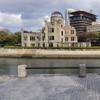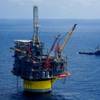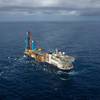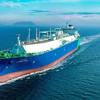The Incat Tasmania-built ship, HSV-X1 Joint Venture, has arrived back at Hobart, Tasmania,
returning from the Persian Gulf in service with U.S. defense forces.
As the High Speed Vessel HSV-X1 Joint Venture (Incat hull 050) left Tasmanian waters on the
evening of September 11, 2001 (AEST) the towers of the World Trade Center fell in New York.
The ship which had been chartered for experimental purposes did participate in a number of
exercises and experiments but quite quickly went into service in the War against Terrorism.
Joint Venture has excelled during her deployment in the Persian Gulf in support of Operation Iraqi
Freedom. Just hours after Operation Iraqi Freedom began, Joint Venture sped into the shallow
Persian Gulf waters near the southern Iraqi port of Umm Qasr, acting as an afloat forward staging
base for Marine Fleet Anti-Terrorism Security Teams and Navy SEAL commandos.
On board with the Joint Venture Navy crew is another US Navy team who will form a second crew
for HSV 2 Swift. The Navy crew joined the vessel in the Middle East for the trip to Hobart as a
familiarization and training run for their forthcoming high speed service on Swift.
Joint Venture returns to the shipyard at Hobart for a brief period of scheduled maintenance. Arriving
under US Navy control on August 14, the ship will be handed over to the US Army during the
course of the maintenance period.
Speaking of Joint Venture’s role in the Gulf, the craft’s Commanding Officer, Captain Philip Beierl
said, “it performed extremely well, operating in waters as shallow as five metres – a capability the
Navy had never previously known.”
“If I had my way, there would be more Incat ships in the Navy,” Captain Beierl said.
In 2001, joint forces from the US Military awarded to Bollinger / Incat USA the charter for a High
Speed Craft to be used as an evaluation platform for various trials and demonstrations for the
different forces involved.
Sponsored Content
Protect Your Crew. Exceed Weld Standards.

MSC Sets a New Standard for Time Off in 2025, Plus Earn a $44,345 Bonus as an Able Seaman!

August 2025
 Read the Magazine
Read the Magazine

 Read the Magazine
Read the Magazine
This issue sponsored by:

By the Numbers: Mitigating Maritime Risk: Inside AWO’s Falls Overboard Prevention Report
Subscribe for
Maritime Reporter E-News
Maritime Reporter E-News is the maritime industry's largest circulation and most authoritative ENews Service, delivered to your Email five times per week








